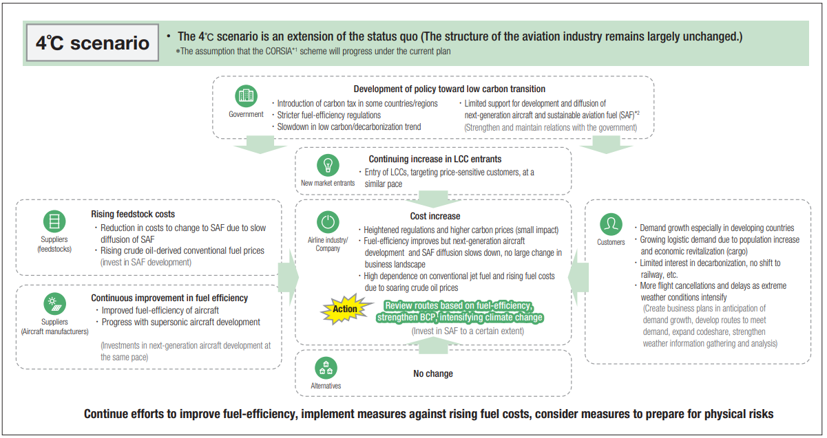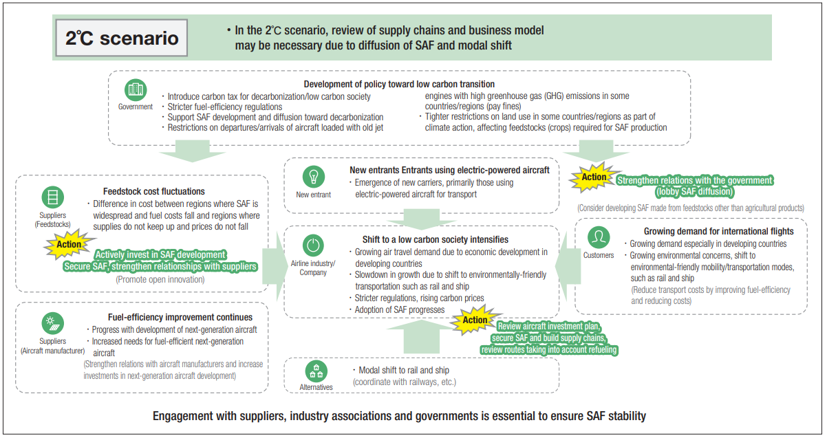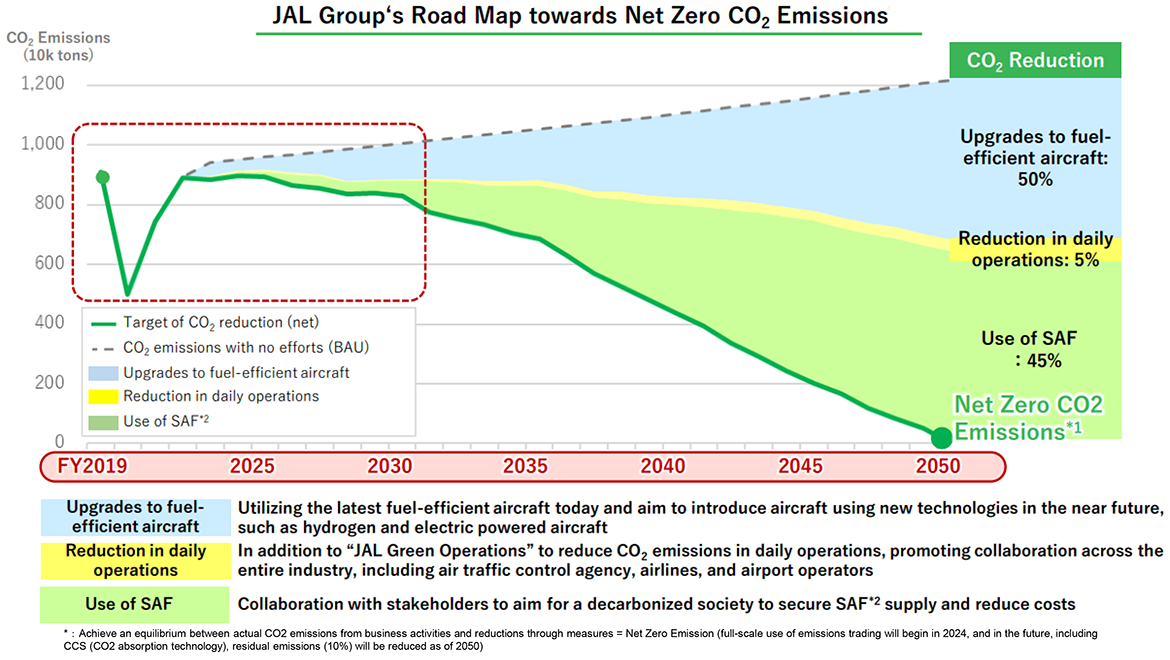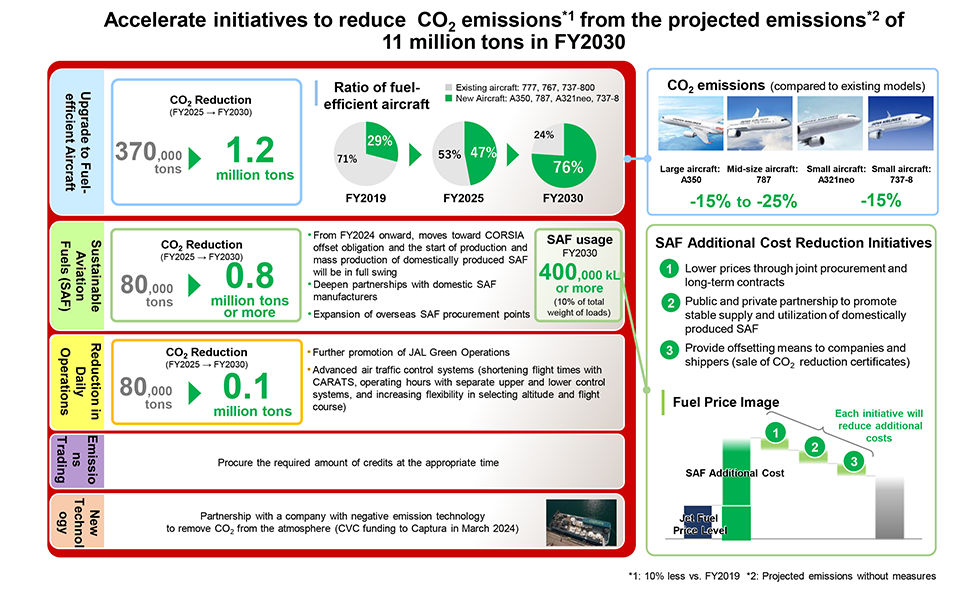Addressing Climate Change
Basic Concept
The JAL Group has established the "JAL Group Environmental Policy" and is promoting various initiatives to fulfill its responsibility to pass on the precious Earth to the next generation.
Currently, various environmental issues are becoming apparent on Earth, and the JAL Group recognizes that action on climate change is a particularly important issue for the sustainability of society. As part of its responsibility as an air transport operator, at the shareholders' meeting in June 2020, the commitment to achieve Net Zero CO2 Emissions by 2050 was declared, to steadily promote various initiatives including the reduction of CO2 emissions. Also, in February 2021, the JAL Group agreed to the recommendations of the Task Force on Climate-related Financial Disclosures (TCFD), and will continue to regularly disclose information in accordance with the TCFD and its successor, the ISSB Standards. In addition, the JAL Group will continue to closely monitor developments of the Science Based Targets initiative (SBTi) and will work to achieve the SBTi's goal of Net Zero CO2 Emissions by 2050.
Furthermore, in the Medium-Term Management Plan Rolling Plan 2023 announced in May 2023, the JAL Group announced its commitment to work to achieve JAL Vision 2030 and positioned the ESG strategy as the topmost strategy to realize value creation and growth. In terms of addressing climate change, to achieve medium- to long-term growth and sustainably improve corporate value through reducing risks and seizing opportunities, the JAL Group will not only sincerely work on CO2 reduction in daily business activities but will also work on capacity building on environmental issues by means of stakeholder engagement; by actively promoting technological innovations to improve fuel efficiency and the development/production of Sustainable Aviation Fuel (SAF) in collaboration with stakeholders.

Governance
The JAL Group's Board of Directors demonstrates a strong supervisory function through periodic reporting (four times in FY2023) on the execution of initiatives concerning climate change and biodiversity. In the execution, the Sustainability Promotion Council, chaired by the President, formulates basic policies, sets important targets and manages progress, and deliberates and decides on policies to deal with issues. The Sustainability Promotion Committee, chaired by the Senior Vice President of the General Affairs Division, deliberates on issues identified through the Environmental Management System (EMS) and issues identified through the GX-related Officers Committee.
In addition, the Medium Term Management Plan incorporates addressing climate change into its management strategy and defines eight key sustainability issues (materiality) to address social issues through its business operations. With a strong commitment to achieve sustainable business operations and enhance corporate value through steady efforts to address these issues, we reflect external ESG ratings and CO2 emission reduction targets in officer remuneration as indicators.

*GX Related Officers Committee : FY2023 results : Eight times; members: General Affairs Division, Corporate Planning Division, Procurement Division, Route Business Division, Solution Sales Division, Cargo and Mail Division, Business Administration Division, Policy Center, (secretariat) ESG Promotion Department
Issues presented and reported at the Board of Directors and the Sustainability Promotion Council in FY 2023
- Development of goals related to addressing climate change (transition plan), and annual results
- Progress on the GX strategy to achieve Net Zero CO2 Emissions by 2050
- Disclosure on TCFD and TNFD, EMS review
Strategy
Scenario Analysis
The international community is rapidly moving toward a 1.5°C scenario as the benchmark for climate change action, with tighter environmental laws and regulations in Europe, the United States' return to the Paris Agreement, Japan's Carbon Neutral Declaration and a major review of its national reduction targets (NDC), and the de facto 1.5°C target agreement at COP26.
In 2018, the JAL Group participated in the “Project to Support Analysis of Scenarios of Climate Risks and Opportunities in line with TCFD Recommendations” organized by the Ministry of the Environment of Japan and predicted the society in 2030 based on two scenarios (RCP8.5*1, RCP2.6*2) of the International Energy Agency (IEA) and the Intergovernmental Panel on Climate Change (IPCC), that is, keeping global warming to below 4℃ and below 2℃ by the end of the century.
*1 RCP8.5 scenario: High-level reference scenario in the IPCC Fifth Assessment Report (scenario corresponding to maximum greenhouse gas emissions in 2100)
*2 RCP2.6 scenario: Lowest stabilization scenario in the IPCC Fifth Assessment Report (lowest emissions scenario developed with the goal of limiting future temperature increase to below 2℃)


JAL Group's Transition Plan to Achieve Net Zero CO2 Emissions
Based on the premise of realizing the 1.5℃ scenario, the JAL Group announced that it set a target of Net Zero CO2 Emissions by 2050 at its shareholders' meeting in June 2020. The roadmap in below was created in consideration of risks and opportunities based on the IEA SDS*3 scenario and other factors, which was reflected in FY2021-2025 JAL Group Medium Term Management Plan Rolling Plan 2021 and in the same Rolling Plan 2022. GX Strategy was formulated and reflected from the same Rolling Plan 2023.
With regard to the reduction of CO2 emissions from JAL Group aircraft, we are studying CO2 emissions reduction scenarios targeting 2050 with reference to the latest study materials at ICAO, IATA and the latest scenarios such as WAYPOINT 2050*5 from ATAG*4 , and discussing future issues and measures. In preparing the scenarios, we calculated the total CO2 emissions by 2050 by setting the growth of RTK (paid ton-kilometer) based on total demand for both international and domestic flights, and reflected the effects of each initiative.
*3 IEA SDS Scenario: Sustainable Development Scenario, a roadmap to fully achieve the Sustainable Development Goals of the IEA (International Energy Agency).
*4 ATAG (Air Transport Action Group): A globalization coalition that promotes sustainability in the airline industry.
*5 Reference: Waypoint 2050Open link in a new window


In order to strengthen the promotion system for achieving Net Zero CO2 Emissions, a new department dedicated to GX strategy was established in April 2023. JAL will continue to actively work on the use of SAF *6, which is recognized as a particular focus, as well as on internal carbon pricing (ICP) to promote investments and other measures to decarbonize the industry, and GX strategy is being promoted through a wide variety of methods, including the use of negative emission technologies.
*6 SAF (Sustainable Aviation Fuel) = Sustainable aviation fuel. It is said to reduce CO2 emissions by an average of 80% compared to conventional jet fuel throughout its life cycle, from production and procurement of raw materials to manufacturing, transportation, and combustion.
Examples of Recent Initiatives
Financing and investor relations
In March 2022, we issued the world's first transition bond in the aviation industry in order to steadily renew our fleet of highly fuel-efficient aircraft (Airbus A350・Boeing 787, and others) and were selected as a model case for the Climate Transition Finance Model Project for FY2021 by the Ministry of Economy, Trade and Industry. In March 2023, we became the first company in Japan's aviation industry to finance a transition-linked loan with a specific use of funds, and was selected as a recipient of the Ministry of Economy, Trade and Industry's FY2022 Subsidy for Global Warming Countermeasures Promotion Project. Furthermore, we are actively and continuously utilizing ESG finance, such as by issuing transition bonds for the second time in June 2023, the third time in May 2024, and the fourth time in May 2024, and we are holding dialogues with investors to gain their understanding of our initiatives.
Use of Internal Carbon Pricing (ICP)
In April 2023, the company incorporated Internal Carbon Pricing (ICP) as one of its investment decision criteria to accelerate its decarbonization efforts, setting a base price of 15,000 yen per ton of CO2 emissions. (Case studies: 4 cases)
Formulation a plan to promote decarbonization of the air transportation business
In January 2024, we applied for and approved by the Ministry of Land, Infrastructure, Transport and Tourism for a decarbonization promotion plan for the air transportation business that includes quantitative targets and process charts for FY2030 and 2050 with respect to the use of SAF, improvement of flight operations, and introduction of new aircraft environmental technology, among others.
Launch of JAL Corporate SAF Program
In April 2024, we launched the JAL Corporate SAF Program, a new initiative to certify the environmental value of CO2 reductions created through the use of SAF and offer them to corporate customers who fly with the JAL Group. Through this program, we will work together with customers to promote and expand SAF and decarbonize the supply chain by having customers bear a portion of the additional costs of SAF.
Participation in the GX League
From April 2024, we are participating in the GX League, a cross-industry domestic framework for decarbonization. We will promote medium- and long-term CO2 reductions in Japan through collaboration with other industries and companies.
Utilization of negative Emissions technologies
In March 2024, through an investment in Captura, a U.S. venture with Direct Ocean Capture technology, one of the negative Emissions technologies, we are strengthening our partnership with the company to address future diversification of decarbonization methods.
Risks and Opportunities
Climate change will have a negative impact on the air transport business, which is based on the premise of operating in a "safe and secure society," and as a result, it may pose an enormous risk to the business continuity.
In addition, the response to climate change, including the reduction of CO2 emissions by airlines, may have various financial impacts, such as upgrading to fuel-efficient aircraft and responding to carbon pricing.
The JAL Group organizes and examines these factors that affect its business in accordance with the TCFD classification of risks and opportunities related to climate change and lists them in the table below. The categories of "timing" and "impact of occurrence" are as specified below.
The following was reviewed at the Board of Directors meeting on July 17, 2024.




Risk Management
The JAL Group defines risk as any event or action that may impede the achievement of the organization's mission, objectives, or goals, and conducts semiannual risk surveys and assessments. Those assessed as particularly important are positioned as priority risks, and the Group Risk Management Council, chaired by the President, confirms the status of risk management and deliberates and decides on countermeasures.
With regard to environmental issues such as climate change and biodiversity, which are priority issues in our management strategy, we are implementing risk management through the PDCA cycle based on the Environmental Management System (EMS), while taking into account relevant laws, regulations, and policy trends in the international community.
Risks related to climate change, both transition risks and physical risks, are managed in the risk management system of the entire JAL Group.
Indicators and Targets
In order to pass on our precious Earth to the next generation, the JAL Group sets indicators and targets for environmental data such as CO2 emissions, waste and water consumption, and discloses the results.
Due to the nature of the air transportation business, direct emissions from aircraft account for about 99 percent of CO2 emissions. Based on this fact, we are addressing the reduction of CO2 emissions from aircraft as a top priority issue. In addition, we have set high targets for the reduction of CO2 emissions from non-aircraft sources, such as ground facilities and ground vehicles, which account for about 1 percent of total emissions, and are working across the organization to achieve these targets. In order to overcome various challenges related to technological innovation and market formation, we will lead the industry with cutting-edge initiatives while strengthening cooperation and collaboration with various stakeholders in Japan and overseas, in line with the international framework for CO2 reduction and consistent with the "Clean Energy Strategy" of the Japanese government.
Targets and Initiatives for CO2 Reduction by FY2030
In May 2021, the JAL Group became the first Japanese airline to set a specific target for FY2030 (10 percent reduction in total emissions compared to FY2019), and has taken the lead in promoting the decarbonization of the global airline industry through joint procurement of SAF with our alliance menbers and the use of ESG finance when renewing aircraft. We will continue to accelerate our existing efforts, including the steady renewal of fuel-efficient aircraft based on a stable financial base, the steady implementation of daily operational innovations (JAL Green Operations), and the strategic procurement of SAF with specific onboard targets, as well as consider the use of negative emission technologies such as removing and collecting CO2 to achieve our goals. In Japan and other regions, the government's Basic Policies for Economic and Fiscal Management and Reform 2024, Grand Design and Action Plan for New Capitalism, Clean Energy Strategy, and Basic Policy for the Realization of GX clearly state that it will promote the production and distribution of SAF. In order to realize the ambitious goal of replacing 10 percent of all onboard fuel with SAF by FY2030, the JAL Group is actively working toward the commercialization of SAF through public-private partnerships and collaboration with domestic and international stakeholders.
In addition, we have set targets for indirect emissions, which we have steadily reduced, and we have now set a target for direct emissions on the ground (vehicles and ground facilities), which will result in a 35 percent reduction in non-aircraft emissions in FY2030, compared to FY2019. This will further accelerate our efforts to reduce non-aircraft emissions.

Concrete initiatives and information disclosure (aviation)
The JAL Group aims to reduce energy consumption through various initiatives aimed at reducing energy related CO2 emissions from aviation.
Upgrading to fuel-efficient aircraft
In January 2024, the Airbus A350-1000 entered into service on international routes. On international routes, JAL will introduce an additional 20 Airbus A350-900 aircraft, currently serving as the backbone of its domestic routes, and an additional 10 Boeing 787-9 aircraft, starting in 2028. On domestic routes, JAL will introduce 21 Boeing 737-8 aircraft starting from 2026 to replace its current Boeing 737-800 fleet, and 11 Airbus A321neo aircraft starting from 2028 to replace its current the Boeing 767 fleet. These aircraft are fuel-efficient and produce less noise, and can reduce the amount of CO2 emissions by 15% to 25% compared with conventional aircraft.
The JAL Group will work to reduce CO2 emissions by steadily continuing to upgrade to fuel-efficient aircraft, utilizing funds raised in public equity offering in 2020 and ESG financing from March 2022 onward.
Reducing CO2 Emissions in Daily Operations
Based on the fundamental premise of aviation safety's adherence to the principles, a variety of measures to reduce CO2 emissions are devised, including eco-flight initiatives by devising the timing and choice of handling during flight operations, reducing weight of aircraft, and improving fuel efficiency through regular engine internal cleaning.
In addition, by promoting JAL Green Operations, a cross-organizational activity, which monitor the status of each initiative and share the progress within the company, thereby promoting the PDCA cycle to reduce CO2 emissions.
Supporting the Development and the Use of SAF
The JAL Group has set a goal of replacing 1% of fuel on board loads with SAF by FY2025 and 10% or more by FY2030. Aiming to be a leading airline in the use of SAF, the Group is working on a variety of projects, including the use in capital contribution of Fulcrum, a US-based SAF manufacturer, use of SAF produced in Japan for the first time in scheduled flights, and collaboration with partner companies to build supply chains for Japan domestic SAF.
The aviation industry has been working to reduce CO2 emissions from the perspective of reducing fuel consumption. The quality of the fuel used must be changed in order to reduce it further in the future. From this perspective, SAF (Sustainable Aviation Fuel) is being developed and put into practical use in many countries around the world, mainly in Europe and the United States, and it is expected that SAF will be widely used after 2030. In this context, the JAL Group, with the aim of becoming the leading airline in the use of SAF, has set a goal of replacing 10% of fuel on board by 2030. In cooperation with public and private sectors, we will work with stakeholders in Japan and overseas to promote SAF's commercialization.
Engaging in Emissions Trading
In addition to responding to the ICAO CORSIA, the Group also offers JAL Carbon Offset, in cooperation with CHOOOSE AS, as a unique initiative that allows passengers to offset their own CO2 emissions on their flights.
The JAL Group CO2 emissions by region

Topics
Disclosure regarding Climate Change of the JAL Group was selected as a good disclosure example in the TCFD Annual Report (see p. 49)
Furthermore, in the TCFD Consortium's "Guidance on Climate-related Financial Disclosures 3.0 (TCFD Guidance 3.0)" case examples, our disclosure was introduced as a good example, covering past emissions, targets and measures, enabling understanding the positioning of emissions reduction in the face of increasing demand, and setting an interim target for 2030 in conjunction with 2050 target. (page 30)
Concrete initiatives and information disclosure (ground facilities / vehicles)
The JAL Group aims to reduce energy consumption through various initiatives aimed at reducing energy related CO2 emissions from sources other than aviation.
In the ground facilities field, initiatives with the goal of reducing unit energy consumption by 1% or more on average have been promoted. Under the "operator classification evaluation system" of Act on the Rational Use of Energy (Energy Conservation Act) implemented by Ministry of Economy, Trade and Industry, the Group has been certified by S Class good business operator classification for 9 consecutive years since 2015.
In order to achieve its indirect CO2 emission reduction target for FY2030 (50% reduction compared to FY2013), the JAL Group is promoting initiatives such as the use of LED lighting in its facilities, the introduction of air conditioning control systems, and the purchase of non-fossil certificates (the dedicated area for “JAL factory tour ~SKY MUSEUM~" is operated with net zero emissions).
In the ground vehicles field, the JAL Group is actively working to reduce CO2 emissions from vehicles at airports, including the electric vehicles and the introduction of biodiesel fuel.
In addition to reducing CO2 emissions in aviation and non-aeronautical activities, the JAL Group is working to reduce the volume of CO2 emissions in the entire supply chain, including the volume of leftovers in inflight meals and lounges and food waste during cooking, as well as the volume of foodstuffs produced. We are also working to address to climate change in a variety of ways, including by cooperating with "the CONTRAIL Project", an atmospheric observation project.

